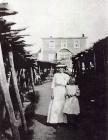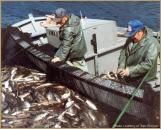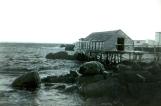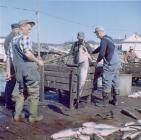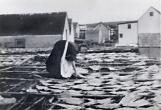14
Cod traps were hauled (gathered together) using trap skiffs, also called motorboats when engines were installed. Punts, which were towed behind the skiff, were used to hold up the heads (top) of the trap when the fish were being taken into the boat using a dip net. The punts were also used for bringing home additional fish when the skiff was full.16
In the early years, the best cod trap berths (locations along the shore where traps were set) went to the crews that were first to get their traps into the water for the season. In order to get the best berths traps were often set very early in the spring while ice was still in the bay. This practice sometimes led to the damage or loss of traps and moorings because of ice floes. To avoid such losses the community eventually decided to allocate berths based on a random draw system. Some fishing crews owned two traps so the community would draw up two lists, one for prime berths, considered to be the best fishing locations, and one for the locations that were not as productive. The fishermen would then randomly draw one location out of a hat for their prime berth. If they owned a second trap, another location would be drawn from the secondary hat.18
A cod trap is hauled until the cod is dried up. This refers to the process of gathering up the net until the fish cannot move around. The catch is then ready to be scooped into the boat using a dip net (a small hand held net on the end of a pole).20
Each fishing crew had its own stage where fish were taken to be cleaned and salted.22
In earlier times, before improved quality control, fishermen would use a fish prong (double hook on a long pole) to throw the fish from the boat onto the stage head and then into a holding box. Each fish was then taken from the box to the splitting table where the gut, the head, and the soundbone (backbone) were removed in preparation for cleaning and salting. Removing the soundbone was called splitting.In later times, when freezing was used to preserve fish, fishermen would remove the gut only, in preparation for filleting later at the local fish plant.
24
After the fish were caught they were headed, gutted and split. They were then packed in salt for several days after which they were washed and laid out on the flakes to dry.25
A woman and child walk between two rows of flakes on Parrott's hill.1910
Scilly Cove (Winterton), Newfoundland
